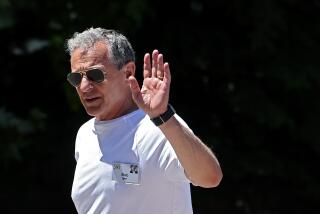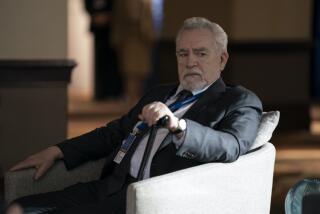Longtime GM Executive to Be Roger Smith’s Successor : Autos: Some analysts feel that Robert C. Stempel’s background will help renew the firm’s focus on its product line. But few think he will make any revolutionary changes.
DETROIT — Hollywood won’t have the Roger of “Roger and Me” to kick around any more.
Roger B. Smith, General Motors’ controversial chairman who has unwittingly become best known to the general public as the absent target of Michael Moore’s savagely satirical film “Roger and Me,” announced Tuesday that he will turn over control of the world’s largest industrial company to Robert C. Stempel. The 56-year-old successor is another longtime GM executive who has been GM’s president and second-in-command since 1987.
But Moore can’t take credit for forcing Smith out of office. Smith, who has been chairman since 1981, longer than anyone since Alfred P. Sloan, the architect of the modern GM, has weathered an almost constant barrage of criticism during his years at the top and is stepping down exactly when he always said he planned to do so--in August, when he reaches GM’s executive retirement age of 65.
While Smith has been a bureaucratic survivor, the final report card on his tenure at GM is likely to be decidely mixed. While some analysts believe that he will be credited in the future for modernizing GM’s aging manufacturing and technological base, his personal leadership and communication skills are likely to be called into question.
“The verdict right now is that he has not been an effective chairman,” observed Chris Cedergren, automotive analyst with J. D. Power & Associates, an Agoura Hills research firm. “But I think in five or six years he will be remembered as a stronger chairman than he is perceived to be now.
“I think his greatest claim to fame will be that he modernized GM. But I think part of the problem with his image right now is that he clearly should have placed a greater emphasis than he did on making GM’s product line more competitive.”
In fact, GM’s weak products brought on the dramatic reduction in the company’s dominance of the American auto industry that has plagued it throughout Smith’s tenure.
Smith took over GM at a time when it still held sway over virtually every aspect of the American auto industry, when Ford, Chrysler--and even many of the imports--still looked to see what GM was doing before making any major moves. Not only did the GM of 1981 control nearly 45% of U.S. car market, but “the General” could also still set the pace in Detroit on pricing, marketing, labor relations and new product development.
While Japanese auto makers were by then a serious threat, GM had just embarked on a $40-billion program to invest in new plants and new products that GM executives felt assured would roll back the import tide.
But instead, GM’s market share plunged 10 percentage points by 1989, and Smith’s ambitious drive to automate and modernize GM’s factories had bogged down in poor execution.
“Hey, Smith’s been through a war,” said a sympathetic Thomas O’Grady, founder of Integrated Automotive Resources, a Wayne, Pa., automotive research firm.
Now, as Smith prepares to leave, Ford and Chrysler no longer follow GM’s lead in pricing or in automotive styling, and many analysts believe that Toyota will soon challenge GM’s traditional ranking as the world’s largest auto maker.
Stempel’s mandate thus must be to shore up GM’s market share. Unlike Smith, who came up through the financial ranks at GM, Stempel has a strong background in engineering and product development and so seems well-suited to help give GM a renewed focus on the product side of the business.
“Bob Stempel (as GM president) has been an absolutely fantastic leader of our operating team,” Smith gushed at a press conference here Tuesday.
But Stempel is not about to bring revolutionary change. He is an affable yet rather colorless GM careerist who has closely guarded his privacy ever since the widely publicized kidnaping of one of his three children from his Bloomfield Hills, Mich., home in 1975, when Stempel was Chevrolet’s chief engineer.
His son, Timothy, then 13, was locked in a car trunk for more than two days and then released unharmed after Stempel paid $150,000 in ransom posted by GM. The kidnapers were quickly arrested by the FBI, and all but $11,000 of the ransom money was recovered.
The kidnaping revealed one measure of just how steeped Stempel is in the General Motors corporate culture: After hearing from the kidnapers, he reportedly called GM security first, the local police second.
Yet in the wake of that traumatic experience, Stempel is unlikely to actively seek the unending swirl of publicity that Smith endured during his tumultuous years in office.
Meanwhile, Lloyd E. Reuss, 53, who moved up through the GM management ranks almost in lock-step with Stempel throughout the 1980s, will succeed Stempel as president.
Stempel’s selection as chairman had been widely expected, but the promotion of Reuss, head of GM’s North American automotive operations, was a mild surprise. Many observers in Detroit were betting on John F. Smith Jr., 51, who is now in charge of GM’s international operations and who put together GM’s car-making joint venture with Toyota in Fremont, Calif.
Although Reuss and Stempel have worked closely together over the years, many believed that his star had fallen recently, while the surging profits of GM’s European subsidiaries seemed to boost John Smith’s chances.
But instead, John Smith, no relation to Roger Smith, was named Tuesday as one of two new GM vice chairmen; the other is Robert J. Schultz, 59, who oversees GM’s major non-automotive subsidiaries, EDS and Hughes Aircraft.
“We’ve got a great team organized here,” Roger Smith said Tuesday. “I’m leaving convinced we’ve got probably the greatest team we’ve ever had because we’ve got some of the greatest challenges we’ve ever had.”
The rise of Stempel and Reuss strongly suggests that GM will not make any dramatic change in its strategy in the next few years despite its deteriorating position in the U.S. car market. Both men have been close to the top of the corporation throughout Roger Smith’s tenure and were largely responsible for carrying out Smith’s policies during the 1980s.
Indeed, reformers inside GM are likely to be disappointed by Reuss’ selection; many still blame him for the problems Buick went through in the early 1980s following his term as general manager of that passenger car division.
Some inside the company had hoped that William Hoglund, widely considered to be one of GM’s brightest executives, would step in and provide an aggressive new direction to the company’s automotive operations. Instead, Hoglund will remain in his current position, overseeing GM’s parts operations--a job some who know him say he is bored with.
GM’s DECADE
1980 1989 U.S. car sales 4,116,482 3,437,086 Market share 46.1% 35.1% Profit (loss) ($763 million) $4.2 billion






